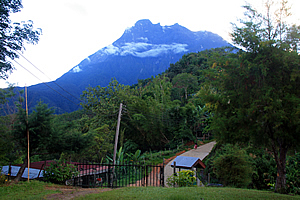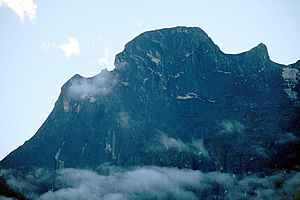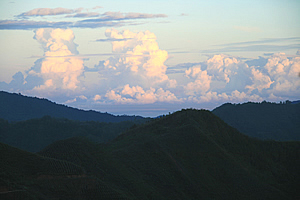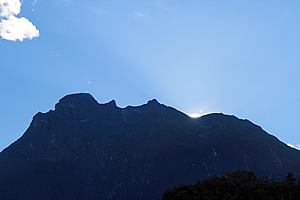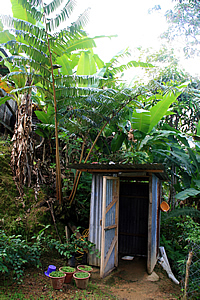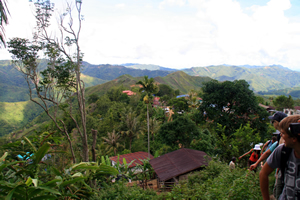--- Archive files ---
Home > Treks > Kinabalu > Day 2 > 2.1 |
Village Perched on the Mountainside
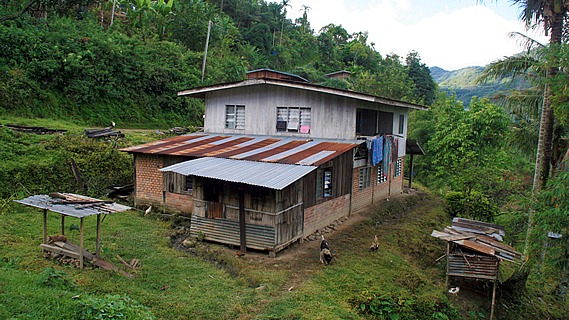
IT WAS cold when I awoke the following morning, perhaps because my previous nights in Borneo at sea level had been warm and never dropping below twenty six degrees. Here I was at 1500 metres above sea level, having slept at an altitude higher than I had ever slept before where the temperature would be a good nine degrees cooler. I was the first up in our group, so I quietly dressed and left the hut. The sky above was perfectly clear without a cloud in the sky. The stairs were steep and awkward to climb down, but I made it to the ground level without any dramas. From there I walked through the covered entertainment area to the end of the buildings to see if I could see the mountain.
Early morning view of Kinabalu from the village |
The view was spectacular. The sun would have already risen well above the horizon, but it was hidden behind the mountain. Although the village was perched at 1500 metres above sea level, the mountain precipitously towered a further 2600 metres above me to stand over four kilometres high. It was a coloured a striking deep purple green, silhouetted strongly against the pale sky. Lingering clouds obscured much of the mountain, but they were swirling around fast enough to afford a complete view after some patience. The mountain stood impossibly steep, the cliff face towered in a precipitous wall to its jagged summits.
From here I also had a clear view of the valleys below. The ridges were clear but the valleys were filled with mist. I could see as far as the sea some ninety kilometres away. Over the sea towered puffy storm clouds flecked with the thin horizontal lines of dark nimbostratus clouds. Hopefully they won’t be coming this way anytime soon. Across the valley I could see paddocks on the side of some of the spurs, with small terraces straddling across them where rows of vegetables grew.
Sheer face of Kinabalu |
I was taken aback by the amazing surroundings. Not only was the view of the mountain and valleys so magnificent, but it terrified me to think that I would be climbing this seemingly impossible purple monstrosity tomorrow. Now I was thinking that perhaps I should have followed through with the decision to retire from mountain climbing after my climb in Hokkaido a couple of years ago.
No! Quitting isn't an option.
Upon my return from Hokkaido I had immediately bought a set of scales and a fitness DVD and started an exercise program. Within twenty two weeks I had lost fifteen kilogrammes dropping from being borderline obese to reaching my optimum BMI. Additionally I was fitter than ever.
Shortly after achieving this I was travelling through Motueka in New Zealand and climbed the nearby 1795 metre high Mount Arthur with ease. Upon reaching the summit I realised there was still hope for me. There and then I officially came out of mountaineering retirement.
Distant storm clouds down the valley below |
Despite that I was saddened that even with my renewed fitness, I would never be able to climb anything higher than the two and a half kilometre high Mount Taranaki. However I started to do some research about places around the world that I wanted to go, and realised in the tropics I could climb mountains far higher than Taranaki. I then realised I could climb mountains even higher than Mount Cook, New Zealand’s highest mountain at 3754 metres. I had stood at the base of Mount Cook before in previous travels, and looking up at its sheer icy slopes I had decided climbing any mountain of that altitude would be totally out of reach.
It was therefore a bold move for me when I walked into my travel agency and told them I wanted to climb Mount Kinabalu. At over four kilometres high, it was Borneo’s highest mountain. The thought of scaling such a high mountain was daunting, but I booked a tour that included the climb anyway. This committed me to it, so I joined a personal training class to further work on my fitness. I had a tough challenge ahead of me, but I was committed to stretching my limits and making it happen.
Now I was here, and upon seeing this most ominous mountain, I was seriously having second thoughts about my capacity to climb it.
Robert and Tobias joined me in marvelling at the mountain. Perhaps they too were also starting to doubt their abilities to climb it. I had by now found out that Robert was just as scared of heights as I am. It seems ridiculous that people like us who struggle to go up a few short steps climbing small ladders would set off climbing mountains over four kilometres high. What drives us to such insanity?
The sun rises over the mountain |
The answer to this would become apparent to me at dawn the day after tomorrow. Until then I just had to grit my teeth and commit to it.
By now the cloud had cleared in front of the mountain. I had a clear view of the purple mountain for just a few moments before the sun streamed over the rightmost saddle of the mountain ridge.
The rest of the group had joined us by now. The bright sun bursting over the mountain made it a lot harder to see. At least the air was quickly warming up. We returned to the hut to get ready for breakfast, and Richard led us back to the house where we had dinner last night. Obviously the same family was entertaining us for our entire stay. Another family will look after the next tour group who comes after us.
A slightly hung over Sapinggi welcomed us into the house. We left our rabble of shoes at the door as we entered the house to once more sit on the floor. The sun flooded through the uncurtained windows harshly illuminating the retro green lino we sat upon.
King fern next to toilet |
We ate a hearty breakfast. There was cereal (I assumed bought from a store unlike dinner last night which had been harvested from the hillside farms just yesterday) and fresh boiled eggs. On the way out I saw the outhouse across the other side of the large car port. Beside the outhouse was a giant fern. The fronds were a good four metres long. Richard told me this was a king fern. This is a ground fern with fronds that can grow up to seven metres long. He had attempted to grow one once, but its water demands were just too heavy, and it finally died. He said a friend of his in Melbourne grew one and succeeded because it was at the edge of a permanent pond despite the cool temperate climate there. I made a note of that. This was a magnificent specimen, and its health was testament to the incredibly high rainfall they have here.
Once breakfast was finished, Muda, the young fellow who had played guitar last night appeared and took us out on a tour of the village. His English wasn’t very good yet, but clearly he was in training to become a mountain guide, so this village tour would be good practice for him. We were all geared up for hiking, but he wore just a blue muscle shirt, black shorts and thongs, appearing very casual.
View back down the village |
We walked up the road past the house where we had dinner and breakfast. We continued walking up the steep gravel road past the several derelict timber houses. They had been built haphazardly out of whatever materials they could find. Their corrugated iron roofs were rusty and the walls were constructed out of all kinds of brick and wooden board. They seemed pretty solid through. Whilst they weren’t perched on the edges of cliffs, the terrain here was quite steep, and the road ran up the ridge towards the mountain, which was now enshrouded in cloud.
The steep road suddenly ended above two hundred metres above the house where we had breakfast. Several narrow walking tracks led from the end of the road in all sorts of directions heading further up the slope towards the rest of the village. We followed one of these narrow and muddy tracks which continued steeply uphill. All building materials used to build the houses would have needed to have been taken up these tracks. Low rough fences were used to separate the properties, each having a small block of land where the owners grew their own vegetables. Most gardens were a little untidy and overgrown, but that didn’t matter. They all looked very productive in this very wet climate on the side of the mountain.
Despite that, one thing these houses had were amazing views of the five hundred metre drop into the depths of the forested valley below, and across to the next range of mountains rising another five hundred metres to about two thousand metres above sea level. Much of the mountain terrain was forested, apart from the occasional village nestled in the valley and a few paddocks clinging to the mountain slopes.
|
We continued walking up the difficult track up the steep ridge until we were near the top of the village. We walked through a well landscaped and maintained overgrown vegetable and herb garden to the entrance of a tiny house. The garden looked very productive no doubt due to the very high year round rainfall here. There was also a small muddy pond full of fish to be taken out and cooked when needed to save the long hike down the hill to the river. Near one end of the rectangular pond was a small round mount with a plant growing out of the top. To the right of the entrance of the house was a shed packed full of firewood and gardening gear.
An old lady named Dayang appeared at the door balancing her frail body on a walking stick. It was rather surprising someone who struggled to walk would live way up here in this almost inaccessible mountainous place. Dayang had mothered ten children and now lived alone spending her days tending her garden. She had everything she needed, so why not live here?
Outside the hut were quite a large number of wooden walking poles. These were all basic metre and a half long sticks with pale purple tape wrapped around one end, but they were all very strong hardwood. Everyone else in the group hired one. I didn’t need to. I had my high tech walking pole with suspension – though regrettably I had not brought it up here with me.
|
Once done, we continued walking along the narrow track. About ten metres down the track we passed a couple of houses where I saw a small wooden xylophone on the side of the track made from about eight slats of crudely cut wood nailed onto two longer pieces. Muda took the opportunity to once more demonstrate his musicianship by bashing out a very woody tune.
It quickly turned and started heading steeply downhill. Now I don’t like walking downhill at the best of times, and this track was steep and muddy – the worst kind of downhill I could imagine at the time. To make matters worse, everyone else now had a walking pole to help them balance. I had nothing.
Because everyone else had a walking pole and I was at the front, I was slowing the group down a lot. But somehow we all made it down the muddy hill, over a couple of sties. I was so relieved to be back on the road, although the final walk down the road was still rather too steep.
Once more I was doubting my ability to climb the mountain tomorrow.
<< Previous | Next >> |
|
||
About this Page
|
||
|
|
|
Where is Walkabout Jeff? |
|
|
|
|
What is happening in Walkabout Jeff's hometown?
|
|
|
|
|
Who is Walkabout Jeff?Any normal person's idea of going out involves going to the local pub for a drink with a few mates. Walkabout Jeff isn't normal.
|
|
|
|
|
